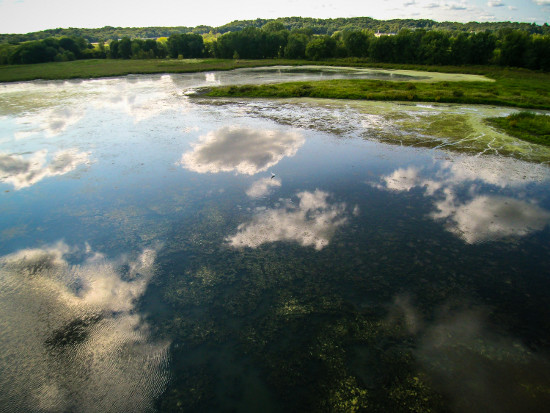
Even a brief visit to Davenport's Nahant Marsh will show something unusual: a wetland habitat nestled in an area that includes an interstate highway, a railroad, and various agricultural and industrial uses. You'll likely see plants and animals that you won't find anywhere else in the Quad Cities area, just a few minutes' drive from the Rockingham Road exit of Interstate 280 in the southwestern part of the city.

"We know it's the largest urban wetland between St. Paul and St. Louis" along the Mississippi River, said Executive Director Brian Ritter. "We think it's one of the largest urban wetlands in the United States."
Yet getting a fuller sense of the marsh requires patience. As Nahant Marsh Board President Tim Murphy noted: "The marsh does not usually reveal itself easily but will come to those that sit and take the time to observe."
In an e-mail, he said that "I really like the beaver complex in the northern part of Nahant proper. ... I never cease to be amazed at how beavers have created a substantial pond on ground that has almost no flow of water. I am very curious to see how this pond will be colonized and used by plants and other animals, as well. This seems to me to be an example of how nature works ... largely outside of human influence. ...
"There are also other fish-free shallow-water excavations that hopefully will become areas that hold and nurture a variety of amphibians, including newts and salamanders. The number of little critters that can be found in the marsh proper is really amazing. ... There are almost always some ducks, geese, herons, or other waterfowl using the marsh. To see a muskrat, beaver, or otter takes quite a bit more luck ... ."
Julie Malake - a photographer, artist, and member of the Friends of Nahant Marsh - offered several examples of repeated, leisurely visits showing different facets of the wetland: "A particularly magical change has been the return of the sandhill cranes," she wrote. "During the first years of going to the marsh [starting in 2006], I saw no cranes. In the spring of 2011, I first saw a crane at Nahant Marsh, and since then, cranes have been regular visitors. This year, sandhill cranes have been seen frequently, and I've been able to observe them often."
She continued by calling Nahant Marsh "a wild, ever-changing garden full of once-widespread native plants, and [it] is extremely popular with many kinds of birds. ... What they [visitors] might see will vary widely from day to day, even moment to moment. I would also recommend to those who do visit to take their time and be still a while. Chances are good that the marsh's residents will forget your presence and simply go about their business. There's always much more going on there than is readily apparent."
The marsh will be celebrating its 15th anniversary as a nature preserve and education center on October 20 with a 5 to 8 p.m. family event featuring "river rat" Kenny Salwey, musicians Ellis Kell and Kendra Swanson, food, and (hopefully) a classic Nahant Sunset. The celebration will provide a taste of what Malake called "a piece of heaven on earth. I love to walk outdoors before dawn, going down to the water's edge to sit quietly as all the colors of sunrise slowly paint their way down the bluff and across the water. I have been going there for almost 10 years now, and no two days have ever been the same. In every season, in every weather, in all the different times, there have been images of beauty, and sometimes surprises."
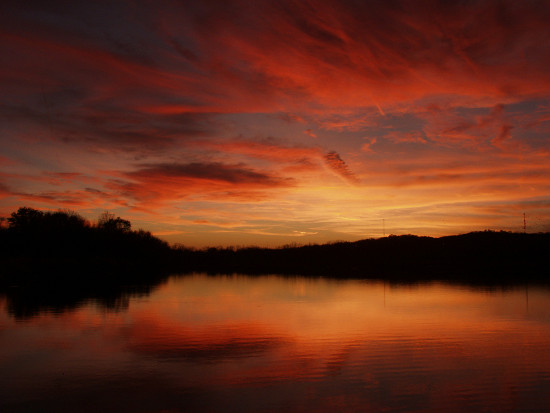
"Nature Is Still Trying to Survive Here"
The biggest surprise is that Nahant Marsh exists at all. "In spite of all the abuse this area has had along with the proximity of industry," wrote Friends of Nahant Marsh Secretary Lynn Abel, "there are still Blanding's turtles here, and you can still see a river otter sliding into the water. Nature is still trying to survive here."
"This place was really almost lost," Ritter said. "It was on the verge of extinction several times. ... We're beyond that. We're growing, and we're growing rapidly."
When Ritter started in 2007, the marsh hosted 1,500 people for educational programming, and he was the only staff member. Last year, the marsh had 15,000 visitors, and it has a new marketing and event coordinator, a full-time and a part-time educator, a natural-resources manager, and 2.5 staffers from the AmeriCorps program. Earlier this year it completed a $250,000 expansion of its education center. Nahant Marsh recently purchased a drone for scientific research - and the aerial cover photo at the top of this article was taken from it.
Fifteen years ago, Ritter said, South Concord Street and Wapello Avenue were considered the dumping grounds of Davenport. "You would have been able to find any piece of trash you can think of," he said, with garbage including an ATM, couches, TVs, and a truck. "That's the image people had of southwest Davenport - it's a place to get rid of your trash."
But, he added, "we've severely curtailed that." On cleanup days in 2007, "we'd have 100 people out here, and we still wouldn't be able to get all the trash. This past year, we only requested 50 volunteers, and we were running out of things to do by noon."
The size of the City of Davenport-owned Nahant Marsh has grown since it was a 115-acre Superfund site in the late 1990s, and it now encompasses 265 acres, with land acquired piece-by-piece over the past decade and a half. "There's actually about 550 acres of wetlands down here," Ritter said, "and our long-term vision is to maybe acquire those or at least get those owners to put some type of conservation easement on them."
Nahant Marsh includes 225 acres northeast of Interstate 280, with the additional acreage including Carp Lake - acquired in 2005 - on the other side. Ritter said the marsh recently secured seven small parcels along the railroad from the county.
And within Nahant Marsh is an impressive diversity of nature. Ritter said the preserve has 410 species of plants, although "50 or 60 of those are invasive species." Rare native species include the ear-leaved false foxglove and the pink turtlehead.
The bird population includes 154 species, 75 of which nest at Nahant. Sandhill cranes hadn't been observed until the past decade, and a pair nests at the marsh. The northern harrier is endangered in Iowa, as is the red-shouldered hawk - which occasionally nests at Nahant.
There are 34 species of mammals, seven species of frogs and toads, at least five species of turtles, and five confirmed species of snakes. Nahant has found and marked 22 Blanding's turtles, and last year a hatchling was found for the first time in at least a decade.
"We're hoping that what we're doing is making it possible for those animals to reproduce here," Ritter said.
You can find monarch butterflies and rare dragonflies at Nahant, but "we have not done extensive insect studies," Ritter said. "That's kind of the next area we want to tackle."
It's an example of how, even after 15 years, the work at Nahant is never done.
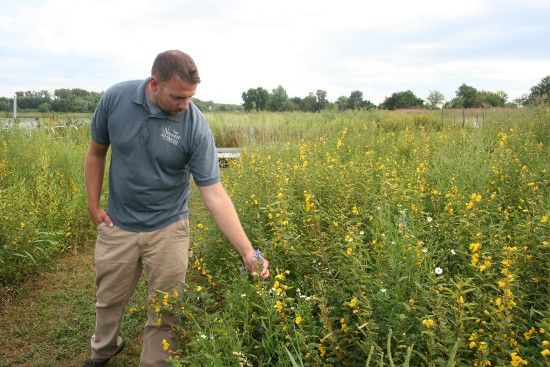
Undervalued Ecosystems
The loss of wetlands - areas where the soil is saturated for at least some portion of the year - has been a nationwide problem. According to the U.S. Environmental Protection Agency (EPA), "In the 1600s, over 220 million acres of wetlands are thought to have existed in the lower 48 states. Since then, ... over half of our original wetlands in the lower 48 have been drained and converted to other uses. The years from the mid-1950s to the mid-1970s were a time of major wetland loss, but since then the rate of loss has decreased."
Yet "between 2004 and 2009, an estimated 62,300 acres of wetlands were lost in the conterminous United States."
Loss has been particularly acute in the Midwest. Between the 1780s and 1980s, Iowa lost 89 percent of its wetland acreage, and Illinois lost 85 percent. The numbers are similar in Missouri, Indiana, Ohio, and Kentucky - and the region is only rivaled by California in terms of wetland loss.
The reason for this destruction, Ritter said, is rooted in the fact that "wetlands historically were viewed as wastelands. ... Wherever you had settlement near a wetland, that wetland didn't last very long. ...
"I don't think people realized the value of what wetlands actually do - the fact that they filter water and they produce hundreds of different species of animals. ... People have the idea of a marsh being a swampy, mosquito-infested area that you don't want to go to." (Actually, Ritter said, marshes have lots of animals that feed on mosquitoes.)
According to the WWF, "Wetland ecosystems are often undervalued. ... These complex habitats act as giant sponges, soaking up rainfall and slowly releasing it over time. Wetlands are like highly efficient sewage treatment works, absorbing chemicals, filtering pollutants and sediments, breaking down suspended solids, and neutralizing harmful bacteria. They are also the most biologically diverse ecosystems on Earth."
"The only thing that's more productive [than wetlands in terms of plants and wildlife] are tropical rainforests," Ritter said. "These are the tropical rainforests of the north. ... Almost every animal that lives in the Midwest spends at least part of its time in some type of wetland. ... We don't allow hunting here, but if you're a hunter or a fisherman, you should be very appreciative that we have places like this, because this place is producing all kinds of wildlife that migrate elsewhere eventually."
Nahant Marsh, he said, survived largely undisturbed late into the 1960s - most likely a result of Davenport not having grown that far southwest until the middle of the 20th Century. "Nobody was doing anything down here," he said. "You can't farm this; it's too wet. You can't build Walmart here unless you fill it in. It's a great place for a gun club."
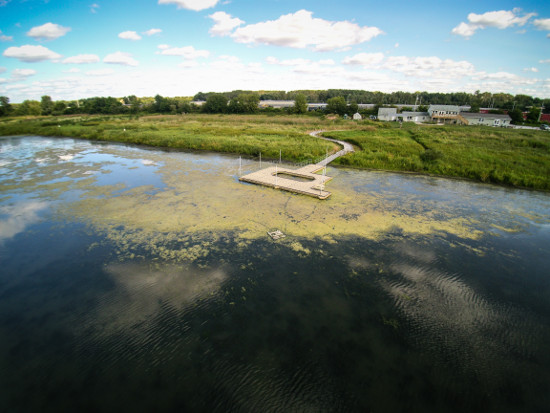
Poisoning but Saving the Marsh
And so in 1969, the Scott County Sportsmen's Association Trap & Skeet Shooting Club relocated its shooting site from Bettendorf to Nahant Marsh - and remained active there until 1995.
According to the U.S. Fish & Wildlife Service's 2001 Final Natural Resource Restoration Plan for Nahant Marsh, "an estimated 243 tons of lead shot were deposited in a 70-acre portion of the marsh based on gun-club shooting records."
"By the '90s," Ritter said, "there are areas in here where you could pull up a handful of mud and get hundreds of lead shot."
The effects on the marsh, he said, were wide-ranging, but most obviously the lead shot affected waterfowl. "You can think of Nahant Marsh as like a rest stop on the highway; the highway is the Mississippi River," Ritter said. Ducks and geese would stop there to rest, feed, and occasionally breed. "Ducks and geese don't have teeth, so in order to break down the food they eat, they eat little bits of rock or grit," he said. But "instead of finding rock and grit, they're finding lead shot. ... It just takes one lead BB to kill a duck or a goose."
It's also likely that lead was leaching into the ecosystem. Cattails readily absorb toxins, Ritter said, and some, "instead of looking like a hot dog on a stick, looked like some deformed hand sticking out of the water. That lead was getting in the cattails as well. ...
"There were other animals that would feed on the cattails. Muskrats - that's one of their favorite food sources - they were probably getting poisoned."
And "as ducks and geese get sick and die from lead poisoning, lots of things like to scavenge on them" - including bald eagles, coyotes, and raccoons. "It's very possible that we were getting secondary and tertiary poisoning."
It's easy to fault the shooting club for the damage it did to the Davenport wetland, but even though its activities poisoned Nahant Marsh, the organization's presence likely also saved it.
"Most of the wetlands that once existed in Iowa are gone," Ritter said, "and the fact that this one survived - especially the fact that it's in an urban area - is absolutely incredible. ... Had the gun club not been here, it probably would have been filled in sometime in the '70s. ... The stars aligned."
He added that pollution of the marsh created an impetus for further action: "It really took this catastrophe to get the community involved and get enough pressure on the federal government to come in and actually clean it up."
Complaints about sick and dead waterfowl led to a U.S. Fish & Wildlife Service investigation, which in turn led to Nahant Marsh being declared a Superfund site. The EPA completed a $2-million cleanup in 1999.
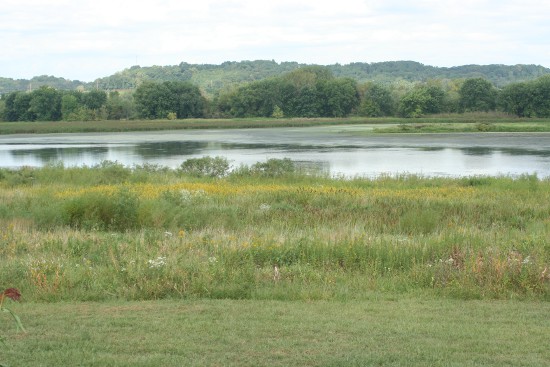
An Ongoing Process
The cleanup, however, was just the beginning of the work at Nahant Marsh, and it stemmed from the work of a variety of organizations, including the EPA, the U.S. Fish & Wildlife Service, River Action, the Quad City Audubon Society, and the Iowa Department of Natural Resources. As part of the Superfund process, the City of Davenport purchased Nahant Marsh from the shooting club.
After the cleanup, Ritter said, the Fish & Wildlife Service worked with the Scott County Conservation Board to plant prairies and sedge meadows, and the Putnam Museum ran education programs. Trail maintenance was done by the Friends of Nahant Marsh.
It remains a partnership among many entities. The city does basic maintenance, the site is overseen by the Nahant Marsh board, and the Friends of Nahant Marsh organization remains active. Eastern Iowa Community Colleges runs education programs.
Including in-kind contributions from various sources, Nahant Marsh has an annual budget of roughly $300,000, but it still needs to raise about $160,000 each year through memberships, grants, corporate sponsorships, donations, and fees for educational programs.
Kent Turner, co-chair of the Friends of Nahant Marsh, wrote that the biggest challenge for the wetland is "the need to find a consistent and reliable funding source for the ongoing financial commitments (salaries, maintenance, etc.) of the marsh."
He also said that while "the large increase in staff seems to have created more, and better, education opportunities for the general public, the overall organization seems to be a bit 'jumbled' at this time. ... I would like to see the center determine what the main focus should be - education [or] preservation?"
Abel, secretary of the Friends group, said an educational focus shouldn't come at the expense of conservation: "I would like to see us have a really high-quality prairie restoration on both sides of the marsh, with much research being done to improve habitat for sensitive species such as the Blanding's turtle. I believe we are close to capacity for school groups, but research should be a focus also. The more we learn, the better able we will be to make this a safe, healthy habitat for the creatures who were here first."
It's crucial to understand that preservation of Nahant Marsh is an ongoing project. Friends of Nahant Marsh member Malake noted that areas near the wetland are still a dumping ground: "On August 8, a staggering amount of trash was picked up from near the intersection of Wapello and Concord, an area Nahant Marsh patrols for Xstream Cleanup events. ... Yet today as I write this, that same area is already full of more dumped tires and more trash."
And it requires lots of human intervention to maintain Nahant Marsh in its "natural" state - which is to say the way it was before human settlement. Staff regularly conducts controlled burns and seeds native plants, and Nahant Marsh rents goats each year to clear invasive brush. Nahant Marsh leadership, Ritter said, is mulling whether it wants to get rid of trees in the marsh, which aren't native to the wetland ecosystem.
"We have these tiny little pockets of nature, these preserves, ... surrounded by a sea of humanity," he explained. "The old approach to preserves was that you just walk away from them, and nature will take care of it. That's not the case at all. If you neglect a small preserve, it'll quickly get overrun by invasive species. It'll quickly get degraded and essentially become a monoculture."
Two key factors contribute to this situation.
First, "hydrology has been altered here," Ritter said. Farmers dug drainage ditches in the 1930s and '40s, for example, and that combined with the Interstate 280 culvert means Nahant Marsh is much wetter than it once was. So the marsh has a control structure with which staff can adjust water levels. "We try to mimic what nature would be doing," Ritter said - which means drying out the marsh in the summer and letting water levels rise in the fall.
Second, invasive species easily make their way into Nahant. "It's a constant struggle to maintain biodiversity in a place that is so surrounded by industrialization," Ritter said. The highway and railroad are key sources.
"It's because those areas are disturbed," he said. "They're mowed or sprayed with chemicals frequently. The things that pop up if you don't continue the mowing usually are the plants that are the most adaptable, which in this area happens to be a lot of the invasive species." With trains and vehicles traveling at high speeds, the seeds get spread more widely.
The Mississippi River, too, is a source of invasive species, which has been problematic as floods have become more common. "Any seeds that the river is picking up - or it could be insects - are going to wash in here [during floods]. We have to remain vigilant."
After the 2008 flood, he noted, "we weren't proactive enough about replanting prairie, and those areas that were most affected just became full of invasive species."
That challenge persists regardless of floods. In the marsh last week, Ritter pointed to dense pockets of reed canary grass - an invasive species that can't be eradicated with controlled burns. Nahant Marsh is considering spraying chemicals to get rid of the species - clearly a tool of last resort.
Yet the fight against invasive species illustrates one of the great appeals of Nahant Marsh: It's a natural treasure hidden in an industrial section of an urban area. Ritter told of having a booth at events such as Bald Eagle Days and talking to people who had no idea that Nahant Marsh even existed so close to home.
"The biggest surprise is finding out that we're here," he said. People would ask: "Where is this? Is this in Missouri?" And he'd respond: "No, it's right here in your backyard. ... This ... is so accessible. We're right next to an interstate."
As longtime Nahant Marsh board member and volunteer Curtis Lundy wrote: "Five miles from downtown Davenport, our community has an extraordinary natural habitat that features wetland pond, mesic and sand prairies, and woodland bottoms. Nahant Marsh is close and extremely valuable to our community. And it is fragile. Fighting for its health, which will greatly enhance the QCA community, is my favorite battle."
And how does he get people to visit for the first time? "I tell them I'll give them $50 if they visit Nahant and don't have an experience that far exceeds $50."
Registration for the October 20 anniversary event is required, and tickets are $5 for Nahant Marsh members 14 and older and $10 for nonmembers. Children are free. Tickets and more information about Nahant Marsh are available at NahantMarsh.org.








